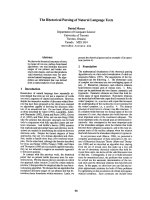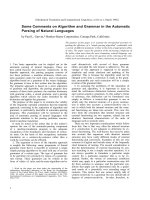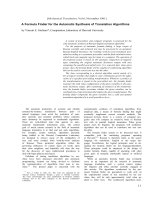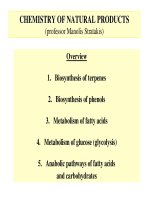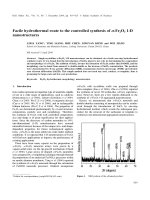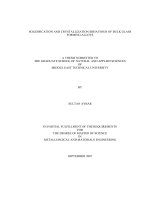Volume 11 the total synthesis of natural products
Bạn đang xem bản rút gọn của tài liệu. Xem và tải ngay bản đầy đủ của tài liệu tại đây (20.07 MB, 494 trang )
THE TOTAL SYNTHESIS
OF NATURAL PRODUCTS
Edited by
David Goldsmith
Department of Chemistry
Emory University
Atlanta, Georgia
.......
.......
THE TOTAL SYNTHESIS
OF NATURAL PRODUCTS
Volume 11
A Sesquidecade of Sesquiterpenes:
Total Synthesis, 1980-1994
Part B: Bicyclic and Tricyclic Sesquiterpenes
Michael C. Pirrung, Andrew T. Morehead, Jr.,
and Bruce G. Young
Department of Chemistry
Duke University
Durham, North Carolina
A Wiley-Interscience Publication
JOHN WILEY & SONS, INC.
New York
Chichester
Weinheim
Brisbane
Singapore
Toronto
This book is printed on acid-free paper. @
Copyright 0 2000 by John Wiley & Sons, Inc.
All rights reserved. Published simultaneously in Canada.
No part of this publication may be reproduced, stored in a retrieval system or transmitted
in any form or by any means, electronic, mechanical, photocopying, recording, scanning or
otherwise, except as permitted under Sections 107 or 108 of the 1976 United States
Copyright Act, without either the prior written permission of the Publisher, or
authorization through payment of the appropriate per-copy fee to the Copyright Clearance
Center, 222 Rosewood Drive, Danvers, MA 01923, (978) 750-8400, fax (978) 750-4744.
Requests to the Publisher for permission should be addressed to the Permissions
Department, John Wiley & Sons, Inc., 605 Third Avenue, New York, NY 10158-0012,
(212) 850-6011, fax (212) 850-6008, E-mail PERMREQ @ WILEY.COM.
For ordering and customer service, call 1-800-CALL-WILEY.
Library of Congress Cataloging-in-PublicationData:
CIP data available.
ISBN 0-471-18874-3
10 9 8 7 6 5 4 3 2 1
CONTENTS
Acknowledgments
..........................................
...............................................
Reagent Glossary ..........................................
111. BICYCLIC SESQUITERPENES ........................
Introduction
A. Eudesmanes ........................................
1. P-Eudesmol, a-Eudesmol, Intermediol,
Neointermediol, Amiteol, Cycloeudesmol, Maaliol, aSelinene, P-Selinene, y-Selinene, Selinadiene, AE 1,
Vetiselinene . . . . . . . . . . . . . . . . . . . . . . . . . . . . . . . . . . . .
2. P-Dictyopterol, Selin-4(15)-ene-l~,ll-diol,Balanitol,
Occidentalol, Isochamaecynone, Chamaecynone,
Emmotin-G, Occidol . . . . . . . . . . . . . . . . . . . . . . . . . . . . .
3. Amitermes Defensive Substance, Isocelorbicol . . . . . . .
4. a-Cyperone, p-Cyperone, Carissone . . . . . . . . . . . . . . . .
5. Eudesma-4( 14),7(11)-diene-8-one,Arctiol, P-Costol,
P-Costal, Isocostic Acid, 3-Oxoisocostic Acid, 1Oxocostic Acid . . . . . . . . . . . . . . . . . . . . . . . . . . . . . . . . . .
6. a-Costal, 7-Hydroxycostol, 7-Hydroxycostal . . . . . . . . .
7. 3-Oxoeudesmatrienoic Acid, 12,15-Dioxaselina-4,11diene ...........................................
8. Junenol, Acolamone . . . . . . . . . . . . . . . . . . . . . . . . . . . . .
9. Atractylon, Lindestrene, Tubipofuran . . . . . . . . . . . . . .
10. Glutinosone . . . . . . . . . . . . . . . . . . . . . . . . . . . . . . . . . . . . .
11. Dehydroasterolide, Dihydrocallitrisin,
Isoalantolactone, Septuplinolide, Ivalin,
Oxodiplophyllin, Yomogin . . . . . . . . . . . . . . . . . . . . . . . .
12. Frullanolide, Tuberiferin, Deoxybrachylaenolide,
Gazanolide, Arbusculin D, 3-0x0-11-hydroxyeudesmadienolide, Magnolialide, Maritimin,
Dihydrosantamarine, asantonin . . . . . . . . . . . . . . . . . .
xi
xiii
xv
1
1
1
10
14
15
17
20
21
22
23
25
25
29
V
vi
Contents
B . Cadinanes ..........................................
1. Calamenene. Hydroxycalamenenes.
Methoxycalamenenes ............................
2. Mansonones, Perezinone .........................
3 . 7,8-Dihydroxy.ll,12.dehydrocalamenene,Heritol . . . .
4. Lacinilene C ....................................
5. a-Cadinene, y2-Cadinene, e-Cadinene, e-Muurolene,
0-Cadinene, GCadinene ..........................
6. Zonarene, Dihydropernetic Acid B, Veticadinol,
Torreyol, Isocalamenediol, Cubenol, Epicubenol . . . .
7. 1,4.Epoxycadinane, Verboccidentafuran, Hibiscone,
Arteannuin B ...................................
8. Halipanicine, Sclerosporin, Sclerosporal, Khusilal ....
C. Drimanes ..........................................
1. Bicyclofarnesic Acid, Drimenol, Albicanyl Acetate,
Albicanol, Farnesiferol A .........................
2. Euryfuran, Valdiviolide, Confertifolin, Isodrimenin,
Cinnamolide, Polygodial, Drimenin ................
3. Fragrolide, Cinnamodial, Warburganal, Isotadeonal,
Muzigidial, Colorata-4(13),8-dienolide,3pAcetoxydrimenin, Pereniporin A, Pereniporin B .....
4. Driman-8,11-diol, Drim-9(1l)-en-8.01, 7-Oxo-llnordrimen-8-en-12-oic Acid, 1,1,5,6Tetramethyltetralin ..............................
D . Eremophilanes ......................................
1. Nootkatone, Valencene, Isovalencenic Acid,
Isovalencenol, Eremoligenol, Eremophilene,
Valerianol, Eremophilone, Dehydrofukinone,
Aristolone, Isopetasol, Petasol, Petasitolone . . . . . . . .
2. Phomenone, Eremofortin B, Sporogen-A0 1 . . . . . . . .
3. Ligularenolide, Ligularone, Petasalbine,
Eremophilenolide, Furanoeremophilone,
Furanoeremophilan-14,6a-olide ....................
E. Miscellaneous Hydronaphthalenes .....................
1. Acetyldehydrorishitinol, Cinalbicol, 4Methoxyisocadalene, 4-Hydroxyisocadalene, 1Hydroxyisocadal-4-one, 2-Methoxy-7-norcalamenene,
Maturone, Platyphyllide ..........................
2. Ambrox, Pallescensin A ..........................
3. Furodysin, Furodysinin ...........................
4. Lemnal-Sa-en-2-0ne, Kanshone A, Nardosinone .....
33
33
38
39
41
42
46
50
52
54
54
57
62
68
70
70
75
77
79
79
83
87
88
Contents
5. Valerane. Valeranone. Cryptofauronol. Fauronyl
Acetate ........................................
6. Isoacanthodoral. Nanaiomoal .....................
7. Thujopsene .....................................
F. Fused Ring Compounds: 6.3 ..........................
1. Sirenin. Sesquicarene. Isosesquicarene . . . . . . . . . . . . . .
G . Fused Ring Compounds: 6.5 ..........................
1. Pterosins .......................................
2. Pacifigorgiol. Tamariscol ..........................
3. Brasilenol. Conocephalenol .......................
4. Axamide-1. Axisonitrile-1. Axamide-4. Axisonitrile-4.
Axisothiocyanate-4. Oppositol .....................
5 . Pinguisone. Deoxopinguisone ....................
6. Alliacolide ......................................
7. Chiloscyphone ..................................
8. Coriamyrtin. Asteromurin. Picrotoxinin. Picrotin . . . .
9. Oplopanone. Anhydrooplopanone . . . . . . . . . . . . . . . . .
10. Bakkenolide A. Homogynolide A. Homogynolide B.
Palmosalide C ...................................
11. Thapsane .......................................
12. Valerenal .......................................
13. 8-Deoxyanisatin. Anisatin. Neoanisatin. Noranisatin .
14. Isovelleral. Stearoylvelutinal ......................
15. Marmalerin .....................................
H . Fused Ring Compounds: 6.7 ..........................
1. ar-Himachalene. a-Himachalene. P-Himachalene. yHimachalene ....................................
2. Perforenone. Guadalupol. Epiguadalupol. Perforene .
3. Widdrol ........................................
4. Pallescensin E. Pallescensin F. Pallescensin G . . . . . . .
I. Fused Ring Compounds: 6.8 ..........................
1. Neolemnane. Neolemnanyl Acetate. Parvifolin . . . . . .
J . Fused Ring Compounds: 5.7 ..........................
1. Lettucenin A ....................................
2. 0-Bulnesene. a-Bulnesol ..........................
3. Gnididione .....................................
4. Curcumenol. Curcumol ...........................
5 . Liguloxide. Kessane ..............................
6. Alismol ........................................
7. Guaianolides: Compressanolide. Estafiatin ..........
8. Guaianolides: Arborescin. 3-Epizaluzanin C.
Zaluzanin C. Mokko Lactone. Dehydrocostus
Lactone. Eremanthin .............................
vii
91
94
96
97
97
101
101
103
104
105
107
109
111
112
116
117
121
121
123
125
125
126
126
129
130
131
132
132
134
134
135
137
138
139
140
141
142
9. Guaianolides: Grosshemin. Oxoisodehydroleucodin.
Jalcagauianolide .................................
10. Pseudoguaianolides: Ambrosanolides-Confertin.
Rudmollin ......................................
11. Pseudoguaianolides: Helananolides- Aromatin.
Aromaticin. Graveolide. Fastigilin C. Carpesiolin . . . .
12. Daucene. Aspterric Acid .........................
13. Mintsulfide. Aphanamol.1. 2-0xoisodauc-5-en-12-al . .
14. Furanol. Furanether A. Furanether B. Furandiol.
Lactarorufin A. Furoscrobiculin B .................
15. African01 .......................................
16. Spathulenol. Alloaromadendrane.4a.lOa.diol.
Cyclocolorenone. Didehydroaromadendrane ........
17. Clavukerin A. Clavukerin C. Clavularin A and B ....
K . Fused Ring Compounds: 5.8 ..........................
1. Precapnelladiene ................................
2. Poitediol .......................................
3. Dactylol ........................................
4. Asteriscanolide ..................................
L . Fused Ring Compounds: 4.9 ..........................
1. Isocaryophyllene. Caryophyllene ..................
2. Punctaporonin B ................................
M . Fused Ring Compounds: 5.5 ..........................
1. Pentalenolactone E ..............................
2. Pentalenolactone. Pentalenolactone G.
Pentalenolactone H. Pentalenolactone P . . . . . . . . . . . .
N . Isolated Rings ......................................
1. Cuparene. Herbertene. Tochuinol .................
2. a.Cuparenone. P-Cuparenone .....................
3. Laurene. Epilaurene. Isolaurene ...................
4. Allolaurinterol. Cyclolaurene .....................
5 . Aplysin. Filiformin. Aplysinol. Isoaplysin ...........
6. Trichodiene. Bazzanene ..........................
7. Trichodermol. Verrucarol .........................
8. Calonectrin. Anguidine ...........................
9. 12.13.Epoxytrichothec.9.ene. 15-Hydroxytrichothec9.12.diene ......................................
10. Neosporol. Sporol ...............................
11. Dihydrofomannosin Acetate. Fomannosin ..........
0. Spirocyclic Systems ..................................
1. Acoradiene. a.Acoradiene. Acoratriene. P.Acoreno1.
P-Acoradiene ...................................
2. Acorone. Acorenone. Acorenone B . . . . . . . . . . . . . . . .
145
147
152
155
157
159
161
163
165
168
168
171
172
174
174
175
177
177
178
182
186
186
191
199
202
204
207
214
217
220
222
224
225
225
229
.
Contents
ix
3. Hinesol. Agarospirol. a.Vetispirene. P-Vetispirene ...
4. P.Vetivone. Anhydro-P-rotunol . . . . . . . . . . . . . . . . . . .
5. Solavetivone. 15.nor.Solavetivone. 3Hydroxysolavetivone. Aglycone A3. Lubimin.
Oxylubimin. Isolubimin. Lubiminol . . . . . . . . . . . . . . . .
6. Vitrenal ........................................
7. Spirolaurenone ..................................
8. Erythrodiene ....................................
9. Cinera.5.7.11.trien. 9.one .........................
10. a.Chamigrene. P.Chamigrene.
Bromomethylenechamigrenone ....................
P . Bridged Systems ....................................
1. P.Santalo1. P.Santalene. epi.P.Santalene. a.Santalo1.
a-Sant alene .....................................
2. a.cis.Bergamotene. P.cis.Bergamotene. p-transBergamotene. (E)-endo-a-Bergamoten-l2-oic acid.
(E)-endo-/3-Bergamoten-12-oic acid. Pinthunamide . .
3 . Helminthosporal .................................
4. Upial ..........................................
5. Nakafuran.8. Nakafuran.9. Dihydropallescensin . . . . .
6. Dihydrospiniferin.1. Spiniferin-1 ...................
234
239
IV TRICYCLIC SESQUITERPENES
.......................
A . Angular Triquinanes ................................
1. Isocomene ......................................
2. Silphinene. 8-0x0-silphinene ......................
3. Pentalenene. Pentalenic Acid .....................
4. Silphiperfolenes. Methyl Cantabrenonate. Subergorgic
Acid ...........................................
B . Propellanes .........................................
1. Modhephene ....................................
C . Linear Triquinanes ..................................
1. Hirsutene .......................................
2. Capnellenes .....................................
3. Coriolin. Hypnophilin ............................
4. Hirsutic Acid C. Cerotopicanol ....................
D . Miscellaneous Fused Tricyclic Sesquiterpenes . . . . . . . . . . .
1. P-Bourbonene. Panasinsene. Italicene ..............
2. Protoillud-6-ene. 8-Hydroxy-protoillud-6-ene. Illudol
3. Punctatin A. Ptaquilosin. Illudin M . . . . . . . . . . . . . . . .
4. Sterpuric Acid. Sterpurene-3.12.14-triol. Sterpurene . .
242
247
249
249
250
251
254
254
262
265
266
268
270
275
275
275
280
286
296
305
305
311
312
325
343
354
357
357
360
363
366
X
Contents
E. Bridged Tricyclic Sesquiterpenes ......................
1. Khusimone. Zizaene. Zizanoic acid. Prezizaene.
Prezizanol. Jinkohol .............................
2. Patchouli alcohol. Norpatchoulenol. Seychellene.
Cycloseychellene ................................
3. Longifolene. Culmorin. Longiborneol ..............
4. Copacamphor. Ylangocamphor. Cyclosativene.
Sativene. cisSativenedio1. Sinularene.
Acetoxysinularene ...............................
5. Quadrone ......................................
6. Cedrene. Isocedrenes. 8.14.Cedranoxide. 8.14.
Cedranediol. Biotol. Pipitzols .....................
7. a.Copaene. fl.Copaene. fl.Ylangene. Lemnalol.
Longipinene ....................................
8. 9-Isocyanopupukeanane ..........................
9. Gymnomitrol ...................................
10. Secoishwaranol. Ishwarane ........................
11. Rhodolauradiol. Khusiol ..........................
..............................................
References ............................................
Epilogue
.............................................
Author Index ..............................................
Subject Index ..............................................
Skeleton Index
370
370
377
382
386
394
406
414
416
418
419
420
422
423
456
461
466
ACKNOWLEDGMENTS
In any large effort such as this, contributions are made by many beyond
those whose names appear on the masthead. Denise Pasternak and Barbara
Goldman, editors at Wiley, will be forever in my debt for their
understanding concerning the trials and tribulations of preparing this
review. David Goldsmith was a very supportive edition editor. Kitty Porter
provided great assistance in the literature search. Financial support for the
preparation of this review came from Abbott Laboratories, Firmenich,
Hoechst-Roussel, Hoffman-La Roche, IFF Foundation, McCormick,
Merrell Dow Pharmaceutical, Robertet, Sunkist Growers, Syntex, USA,
and Zeneca. I greatly appreciated the supportive environment for writing
provided by, initially, the Dyson Perrins Laboratory of the University of
Oxford and J. E. Baldwin, and then by the University of California-San
Diego, J. S. Siege1 and N. S. Finney, and Dr. and Mrs. C. J. Park. Financial
support during these leaves came from the Burroughs Wellcome Fund,
Duke University, and the National Science Foundation.
Michael Pirrung
Durham, North Carolina
xi
INTRODUCTION
This book completes the review of sesquiterpenes synthesized in the time
period 1979-1994, a sesquidecade. Because of the magnitude of this
literature, a smaller portion was published in 1997' as Chapters I and 11,
focusing only on the acyclic and monocyclic sesquiterpenes. This book
comprises Chapters I11 and IV, including the bicyclic and tricyclic
sesquiterpenes (counting only carbocyclic rings, not including cyclopropanes).
In keeping with the title of this series, a natural product must be
prepared for a synthesis to be included. We are sorry to omit the
significant quantity of fine work addressing intricate natural ring systems
or compounds whose structures were misassigned (as discovered by the
synthesis of the erroneous structure), but the size of the literature in
which natural products were prepared necessitates limiting our scope. If
another sesquiterpene is the starting material, a change of carbon skeleton
must occur for a synthesis to be included. We present multiple syntheses
of the same compound in chronological order so that the evolution of
synthetic strategy can be easily seen. In providing legends for the schemes,
syntheses of racemates are not specifically marked. Legends for synthesis
schemes producing optically active compounds include either absolute
configurations, signs of optical rotation, or both. Each scheme is also
identified by the senior author (or the institution at which the work
was conducted). This policy is not intended to underemphasize the
important and valuable contribution of junior authors to the work. Indeed,
many have gone on to achieve significant syntheses of sesquiterpenes in
their independent careers.
Since Part A of this book was published in 1997, a new review article
on sesquiterpene synthesis has appeared summarizing approaches to
triquinanes.2
We look forward to seeing the progress synthetic organic chemistry has
made when 2004 or 2009 arrives and it is time for another author to
undertake the compilation of sesquiterpene total syntheses.
...
Xlll
xiv
Introduction
References
1.M. C. Pirrung and A. T. Morehead, Jr., “A Sesquidecade of Sesquiterpenes:
Total Synthesis, 1979-1994. Part A: Acyclic and Monocyclic Sesquiterpenes,” in
The Total Synthesis of Natural Products, 10,D. Goldsmith, Ed., John Wiley &
Sons, Inc., New York (1997).
2. G. Mehta and A. Srikrishna, Chem. Rev. 97, 671 (1997).
REAGENT GLOSSARY
(+)-DET
18-C-6
9-BBN
Ac
acac
AIBN
APA
aq.
Ar
BHT
BINAP
Bn
Bu
Bz
c-hex
CDI
COD
CP
CSA
CY
DABCO
dba
DBN
DBU
DCC
DDQ
DEAD
DHP
DIBAL-H
Dimsyl
DIPEA
DMAP
DMF
DMP
DMPU
DMS
(+)-Diethyltartrate
Eighteen-crown-six
9-Bora[3.3.l]bicyclononane
Acetyl
Acetylacetone
Azobisisobutyronitrile
3-Aminopropylamine
Aqueous
Aryl
Butylated hydroxy toluene
Binaphthylphosphine
Benzyl
Butyl
Benzoyl
Cyclohexyl
Carbonyl diimidazole
Cyclooctadiene
Cyclopentadieny1
Camphorsulfonic acid
Cyclohexyl
1,4-Diazabicyclo[2.2.2]octane
dibenzylideneacetone
Diazabicyclononene
Diazabicycloundecene
Dicy clohexylcarbodiimide
2,3-Dichloro-5,6-dicyanobenzoquinone
Diethylazodicarboxylate
Dihydropyran
Diisobutylaluminum hydride
Dimethylsulfoxide anion
Diisopropylethyl amine
Dimethylaminopyridine
Dimethylformamide
3,5-Dimethyl pyrazole
N,N’-Dimethylpropyleneurea
Dimethyl sulfide
YV
xvi
Reagent Glossary
DMSO
DPPA
dPPb
dPPe
dPPP
EE
en
Et
EVE
EVK
fur
HMDS
HMPA
HONSu
i-Am
i-Bu
i-Pr
Im
imZC0
imid
K-Selectride@
KAPA
KHMDS
L-Selectride@
LCIA
LDA
LICA
LiHMDS
LiTMP
mCPBA
Me
MEM
MMPP
MOM
MPM
Ms
MVK
n-Bu
NaHMDS
nbd
NBS
NCS
NMMO
NMO
NPSP
Dimethylsulfoxide
Diphenyl phosphorazidate
diphenylphosphinobutane
diphenylphosphinoethane
Diphenylphosphinopropane
1-Ethoxyethylether
Ethylene diamine
Ethyl
Ethyl vinyl ether
Ethyl vinyl ketone
Furan or Fury1
Hexame thyldisilazane
Hexamethylphosphoramide
N-Hy droxysuccinimide
Iso-amyl
Iso-butyl
Iso-propyl
Imidazole
Carbonyl diimidazole
Imidazole
Potassium tri-sec-butylborohydride
Potassium 3-aminopropylamide
Potassium hexamethyldisilazane
Lithium tri-sec-butylborohydride
Lithium N-cyclohexylisopropylamide
Lithium diisopropylamide
Lithium N-isopropylcyclohexylamide
Lithium hexamethyldisilazane
Lithium tetramethylpiperidide
meta-Chloroperoxybenzoic acid
Methyl
2-Methoxyethoxymethyl
Magnesium monoperoxyphthalate
Methoxy methyl ether
4-Methoxyphenylmethyl
Mesyl (methanesulfonyl)
Methyl vinyl ketone
n-Butyl
Sodium hexamethyldisilazane
Norbornadiene
N-Bromosuccinimide
N-Chlorosuccinimide
N-Methylmorpholine-N-oxide
N-Methylmorpholine-N-oxide
N-Phenylseleno pthalimide
Reagent Glossary
OBO
oxone@
P-TsOH
PCC
PDC
Ph
Phe
pic
Piv
PPA
PPTS
Pr
PYr
RaNi
Red-A1
rextal
SEM
t-Amy1
t-Bu
TASF
TBAF
TBDMS
TBDPS
TBHP
TBS
TEBA
TES
Tf
TFA
TFAA
THF
Thx
TIPS
TMEDA
TMS
TPAP
TPP
Tr
trisyl
Ts
x
xs
Trioxabicyclo[2.2.2]octane
Potassium peroxymonosulfate
para-Toluenesulfonic acid
Pyridinium chlorochromate
Pyridinium dichromate
Phenyl
Phenylalanine
Picrate
Piva1y1
Polyphosphoric acid
Pyridinium para-toluenesulfonate
Propyl
Pyridine
Raney Nickel
Sodium bis(2-methoxyethoxy)aluminum
hydride
Recrystallize
2-Trimethylsily lethoxymethyl
tert-Amy1
tert-Butyl
Tris(dimethy1amino)sulfur
(trimethylsily1)difluoride
Tetrabutyl ammonium fluoride
tert-Butyldimethylsilyl
tert-Butyldiphenylsilyl
tert-Butylhydroperoxide
tert-Butyldimethylsilyl
Triethylbutyl ammonium
Triethylsilyl
Triflate (trifluoromethanesulfonate)
Trifluoroacetic acid
Trifluoroacetic anhydride
Tetrahydrofuran
Thexyl
Triisopropylsilyl
Tetramethylethylenediamine
Trimethylsilyl
Tetrapropylammonium perruthenate
Tetraphenylporphyrin
Trityl (triphenylmethyl)
2,4,6-Triisopropylbenzenesulfonate
Tosylate
Chiral Auxilliary
Excess
XVii
The Total Synthesis of Natural Products, Volume11
Edited by David Goldsmith
Copyright © 2000 by John Wiley & Sons, Inc.
Bicyclic Sesquiterpenes
1
111. BICYCLIC
SESQUITERPENES
A. Eudesmanes
I . D-Eudesmol, a-Eudesmol, Intermediol, Neointermediol, Amiteol,
Cycloeudesmol, Maaliol, a-Selinene, PSelinene, YSelinene,
Selinadiene, AE I , Vetiselinene
The simplest of the eudesmanes have mostly served as proving grounds for
synthetic methodologies; hence a number of new methods in cycloaddition
chemistry are seen in the schemes that begin this section.
&OH
%OH
a-eudesrnol
H@
p-eudesmol
cb, qIy
HO’
b
HO” H
cycloeudesrnol
rnaaliol
$by
HU”
h
intermedeol
arniteol
selin-1 1-en-4a-o/
sebna-3,7(1 I)-diene
a-selinene
p-selinene
gselinene
A€ 1
The synthesis of P-eudesmol developed by Mash at the University of Arizona
exploits his methodology for creating chiral cyclopropanes. Intermediate 1 was
used in an earlier eudesmol synthesis by Carlson. Ketalization with (2S,3S)-2,3butanediol and double Grignard addition provide the expected diastereomeric
mixture 3. This is treated with the Simmons-Smith reagent to give an 8:1:8:1
mixture of four isomers. After deketalization, the undesired diastereomeric
series could be selectively destroyed by dehydration. Reductive cyclopropane
A Sesquidecade of Sesquiterpenes
2
opening, ring fusion equilibration, and Wittig methylenation provide the natural
product.
W C O 2 M e
0
T M S O q M S
+
::E",g,*
>@
1.
2.
OH 3.
4.
11
1
2
1. Li/NH3
2. PDC
OH 3. SiOz
4. CH?=PPh?
(79%)
4
3
(77%)
CH212 I ZnCu
HCI
PPTS,A *
separate
(41%)
(+)-p-eudesrnol
(25% overall)
Scheme 1. Mash Synthesis of (+)-P-Eudesmol
Investigation of the intramolecular alkylation of a cyclohexanone resulted in the
formal P-eudesmol synthesis described by Spencer.2 Protection of 5 as an
acetonide permits simple chemistry to form 6. It is converted to its Grignard
reagent for conjugate addition to 3-methylcyclohexenone. Base treatment of 8
results in a diastereotopic group selective reaction to form 9 admixed with its
cis-decalin isomer; equilibration permits full material throughput. Conversion of
the remaining tosylate to a carboxylic acid intercepts an earlier Heathcock
intermediate. A very similar approach, substituting an aldol ring closure, was
later adopted by K a ~ a m a t a . ~
3. LiAIH4
OH OH 4. PPh3ICC14
(66%)
5
"
Nae
___)
2. base
(79%)
~
6
O
4. NH4CI
(65%)
T
1. NaOAc
2. K g 0 3
3, S
(57%)
0
9
7
(70%)
0
known
*
&OH
&OH
10
P-eudesmol
Scheme 2. Spencer Formal Synthesis of P-Eudesmol
The key step in Taber's a-eudesmol synthesis is an internal Diels-Alder
12 is assembled by a straightforward alkylation sequence. The
r e a ~ t i o n .Triene
~
stereoselectivity in its cycloaddition is only moderate, as might be expected.
Bicyclic Sesquiterpenes
+cN
11
1. LDA/&
2. MeLi
3. HCIIH20
4. repeat 2+3
(27%)
-
3
::
itii:te*
OH
12
a-eudesmol
(18.9% Overall)
Scheme 3. Taber Synthesis of a-Eudesmol
An intramolecular nitrone cycloaddition is featured in the a-eudesmol synthesis
of Schwartz of Florida State.5 Methyl farnesate is protected for an acidcatalyzed cyclization by bromohydrin formation at the terminal alkene. This
permits an improved protocol for the formation of methyl monocyclofarnesate
(13). Reduction, preparative HPLC, and reoxidation permit formation of the
nitrone, which undergoes slow cycloaddition to 15. Two methylations allow the
reductive removal of the nitrogen to yield a-eudesmol. Oddly, if technical
sulfolane is used for the methylation, P-eudesmol predominates.
15
(86%)
16
a-eudesml
P-eudesmol
67%
19%
Scheme 4. Schwartz Synthesis of a-Eudesmol
The group of Reissig at Darmstadt completed the a-eudesmol synthesis shown
in Scheme 5.6 It was part of a study of Lewis acid catalysis and stereochemistry
of the internal Diels-Alder reaction involving the formation of 7-membered ring
chelates. Triene 18 was assembled by (carbomethoxy)cyclopropanation of
dienyl ether 17, alkylation of the resulting cyclopropanecarboxylate, and retroaldol reaction. Its cycloaddition gives trans-decalin 19 as 52% of the product.
4
A Sesquidecade of Sesquiterpenes
1 P-TsNHNH~
2. p-TSOH I A I
NaBHGN *
3. MeMgl
(50%)
RoH
a-eudesmol
(10% overall)
Scheme 5. Reissig Synthesis of a-Eudesmol
The defensive secretions of termites contain a number of fascinating terpenes,
including a set of eudesmanes. A group at the Agricultural University at
Wageningen, Netherlands, has completed syntheses of several of the compounds
to confirm their structure^.^ The 3-carbon appendage is attached by a Wittighydroboration-Wittig sequence. Stereochemical control generally derives from
equilibration.
1. MeMgl
1.
2.
3.
4.
OMe 2. HCIIH20
3. MeCH=PPh3
BH31H 2 0 2
PDC
KOHlMeOH
TMSCH~LI,KH
21
20
neointermedeol
(46% Overall)
pl?(
Scheme 6. Wijnberg-de Groot Synthesis of Neointermedeol
1. CH2=PPh3
2. MMPP
2o
@
3. LiAIH4 *
HO"
4. HClIH20
1. MeCH=PPh3
0 2.
3. BH31H202
PDC
22
1. TMSCH~LI,KH
23 2. separate
+
HO"
h
: ;I
23
1. KOH I MeOH
23 2. TMSCHPLi; KH*
intermedeol
(26% Overall)
selin- 1 I-en-.la-ol
(36.5% Overall)
Scheme 7. Wijnberg-de Groot Syntheses of Other Termite Terpenes
Considerable confusion surrounded the structure of cycloeudesmol, a product of
a marine algae; its structure was resolved only around the time of publication of
our previous sesquiterpene retrospective. Two syntheses of this compound have
appeared, the first from Chen.* The 2,6-dimethylcyclohexanonetosylhydrazone
5
Bicyclic Sesquiterpenes
is converted by a Shapiro reaction to the vinyl lithium and then to the allylic
alcohol 26. Orthoester Claisen rearrangement gives a 7: 1 mixture of esters that
is separated, as the acids, by crystallization. Conversion to diazoketone 28
permits diastereoselective cyclopropanation to 29. Double Grignard addition is
preceded by ketone reduction. Reoxidation and Wolff-Kishner deoxygenation
produce the natural product.
0
1
2.
3.
4.
TsNHNH2
n-BuLi I TMEDA
* F
DMF
NaBH4
(76%)
ct;";.
1. MeC(0Et)s
O
H 2. IHf
NaOH
*
3. separate
26
(60%)
OMe
Me
(67%)
28
29
pH
1. MeLi
2. (Me0)ZCO I NaH
3. p-TsNs
27
(79%)
1. NaBH4
2. MeLi
3. Jones
4. NzH4IKOH
cycloeudesmol
(81%)
(20% Overall)
Scheme 8. Chen Synthesis of Cycloeudesmol
A second synthesis of cycloeudesmol was completed .by Ando at Tohoku
U n i ~ e r s i t y .Enone
~
30 was converted to the dienone for a conjugate addition of
cyanide. Stereoselective reduction permits directed epoxidation to introduce the
P-epoxide, which is needed to establish the stereochemistry of the cyclopropane
in a subsequent Stork ring closure to 32. Control of the methyl group
stereochemistry in the A-ring entails formation of the cyclic orthoformate and
d;lb ;::;r*
A.qaCN
*@
1. VO(acac)2I
1 DDQIpTsOH
t-BuOOH
30
H@"'CN 31
1. BusSnH
4.
3. Dibal-H
2.
MeLi
NH&l
(67%)
m
C
H HO 32
'
1. BH3-Me2S
2. NaOHIH202
CN 3. NaH/CS21Mel* ~e
1. Me11
Me2NCH(OMe)2
2. AC2O I A
(86%)
2. 3;5g;0LDAb
(49%)
33
34
-p+%q3yoH
35
(91%)
cyc/oeudesmo/
(12% Overall)
Scheme 9. Ando Synthesis of Cycloeudesmol
N
A Sesquidecade of Sesquiterpenes
6
elimination to the alkene, followed by hydroboration and a xanthate radical
deoxygenation. Elaboration of the nitrile to the isopropylol group is efficient
and rational. Ando has also reported in full form his preparation of all of the
stereoisomers of the erroneous original structure.lo
(+)-Aromadendrene is readily available from eucalyptus oil and constitutes a
useful terpenic starting material. The Wageningen group has used a product of
its ozonolysis, (+)-apoaromadendrone, for the preparation of maaliol. Angular
oxidation is accomplished with dimethyldioxirane via the silyl enol ether.
Methylenation and selective epoxidation set the stage for a pinacol
rearrangement from the 5,7 ring system 38 to the hydronaphthalene. Removal of
the resulting ketone and alcohol in 39 yields the 'bare' maaliane skeleton.
Introduction of a hydroxyl group at the tertiary position by ruthenium tetroxide
is competitive with oxidation adjacent to the cyclopropane, and stereoselective.
bl
1. t-BuOOHl
~ ~ I ~ a x i r a n e ~
(90%)
(+)-apoaromadendrone
ii:iPhs+
(96%)
36
(69%)
VO(acac)n
-
2. TMSCI
(96%)
37
40
(8.6% Overall)
Scheme 10. Wijnberg-de Groot Synthesis of (+)-Maaliol
Two preparations of a-selinene have been described by the Caine group at
Alabama. l2 The P-hydroxyketone 41, derived from carvone oxide, undergoes a
retroaldol reaction on treatment with excess phosphine oxide anion 42. In situ,
the resulting aldehyde is subject to a Wittig-Horner reaction, and the sulfenyl
ketone enolate is methylated. The product is oxidized to sulfoxide 43. Pyrolysis
generates an unsaturated ketone that directly undergoes internal Diels-Alder
reaction. The isomer mixture in 43 is irrelevant to the outcome, as either E or Z
dienes give the same product, evidently by pre-equilibration. The resulting
mixture 44 is deoxygenated and the natural product isolated by preparative GC.
The same Wittig-Horner reagent condenses with limonene-derived aldehyde 45
Bicyclic Sesquiterpenes
7
to give a tetraene that gives mainly gives selinene on cycloaddition, but also
provides a novel cis-eudesmane, helmiscapene.
41
(58%)
42
1. NzH4 I KOH
2. separate
(32%)
(80%)
43
4%
44
*\+%a+%
(-)-a-sehene
sealed
tube
4:1 =E:Z
45
(-)-a-selinene (+)-ahelrnacapene
46
(82%)
(46%)
(14%)
Scheme 11. Caine Syntheses of (-)-a-Selinene
A p-selinene synthesis has been completed by Cohen at Pittsburgh using as the
key step an anion-accelerated vinylcyclobutanol rearrangement. l 3 A
cyclobutanone annulation developed in his lab is applied to perillal. Reduction
of 51 and rearrangement in refluxing THF yield 52. Oxidation and conjugation
permit a relatively difficult conjugate addition of the angular methyl group. The
resulting ketone 54 is the enantiomer of a substance earlier converted to the
natural product, but Cohen devised a more efficient methylenation protocol.
50
peri/lal
51
52
MeCuBF3
2. AlzO3
(65%)
4 steps
53
(47%)
19:i
frans:crs
54
(92%)
(-)-p-selinene
(29%Overall)
Scheme 12. Cohen Synthesis of (-)-p-Selinene
The cation radical Diels-Alder cycloaddition assembles the decalin of selinene in
a formal synthesis developed at UT-Austin.14 Methylenation of perillal gives a
A Sesquidecade of Sesquiterpenes
8
diene that undergoes cycloaddition with phenyl vinyl sulfide promoted by a
photochemical electron-transfer sensitizer. The oxidation of sulfide 55 to a
ketone proceeds with olefin migration to give the known intermediate 53 from
Cohen's work.
O H y )
''if
peri//a/
2.
1. CH2=PPh3
CH2=CHSPh/*
P-(CN)~C&I 1 hv
(50%)
p , , , c*P.,f
55
MoOPh
(41%)
53
Scheme 13. Bauld Formal Synthesis of (-)-p-Selinene
The interconversions of terpene skeletons are of interest based on their possible
mimicry of biosynthetic processes. Itokawa of the Tokyo College of Pharmacy,
in reinvestigating the acid-catalyzed rearrangement of hineso1,l found that 6selinene is produced. This process is the reverse of spirovetivane biosynthesis.
Scheme 14. Itokawa Synthesis of (+)-6-Selinene
The preparation of a nonconjugated selenadiene has been described by Lee of
the Academia Sinica, Taiwan.
Alkylation of methallyl Grignard with
dibromide 56 provides a bromide that can be alkylated with metalated 3-methyl3-sulfolene. Pyrolysis in a stream of nitrogen gives a diene that on prolonged
pyrolysis gives the Diels-Alder product. a-Selinene and a-eudesmol were also
prepared by very similar routes.
y+T'=+
J--JA+)pso2
Cul
56
=-q+
57
1. LiHMDS
2. 180°C
(1 6%, 4 steps)
sealed
tube
(75%)
se/ina-3,7(1 l)-dtene
(1 2% Overall)
Scheme 15. Lee Synthesis of Selina-3,7(1 1)-diene
58
Bicyclic Sesquiterpenes
9
Kutney has used thujone (vide infra) as a chiral starting material for a number of
sesquiterpene syntheses via intermediate 6O.l7,l Here, a Bamford-Stevens
reaction introduces an A-ring alkene but also produces the A2!3 isomer (70:30)
along the way to a-selinene.
*
1. TsNHNH~IBF3
2. N a l b
3. separate
*
(38%)
OH
60
(55%)
61
(-)-a-selinene
Scheme 16. Kutney Syntheses of (-)-a-Selinene
Schinzer of Braunschweig has used the internal cyclization of an allylic silanedienone for the synthesis of another termite natural product, AE1, a cis-decalin
diastereomer of a-selinene.
Stork-Danheiser alkylation of a dihydroorcinolderived enol ether leads to 62. Conversion to the allylic silane 63 and vinyl
lithium addition produce enone 64, which undergoes n-cyclization under
treatment with Lewis acid. This sequence is quite like the Heathcock-Clark
synthesis of nootkatone.20 The angular methyl group is introduced by a nickelcatalyzed conjugate addition. Desaturation and deoxygenation of the ketone
give AEl.
*
)&,
1 03
2. ZnlHOAc
1. RaNi / NaOH
2. HC(OEt)3 I p T s O H - 4
OH 3. LDA /
B -y
(65%)
orcinol
64
OEt3. TM>
62
(47%)
65
(39%)
iTMS
L
@Ll
2. 2M HCI
Ph3*
(15%)
63
OEt (73%)
AE 1
(1.3% Overall)
Scheme 17. Schinzer Synthesis of AE 1
Garratt of University College London has used in a synthesis of vetiselinene21 a
dilithiated cyclohexene-4,5-diester, which is converted by acylation/alkylation to
66. Krapcho decarboxylation, protection, and reduction yield 67, which is
deoxygenated. Hydration of the alkene yields 68, permitting oxidation to set up
a Grignard addition. After dehydration, 69 is 60% of the mixture.



